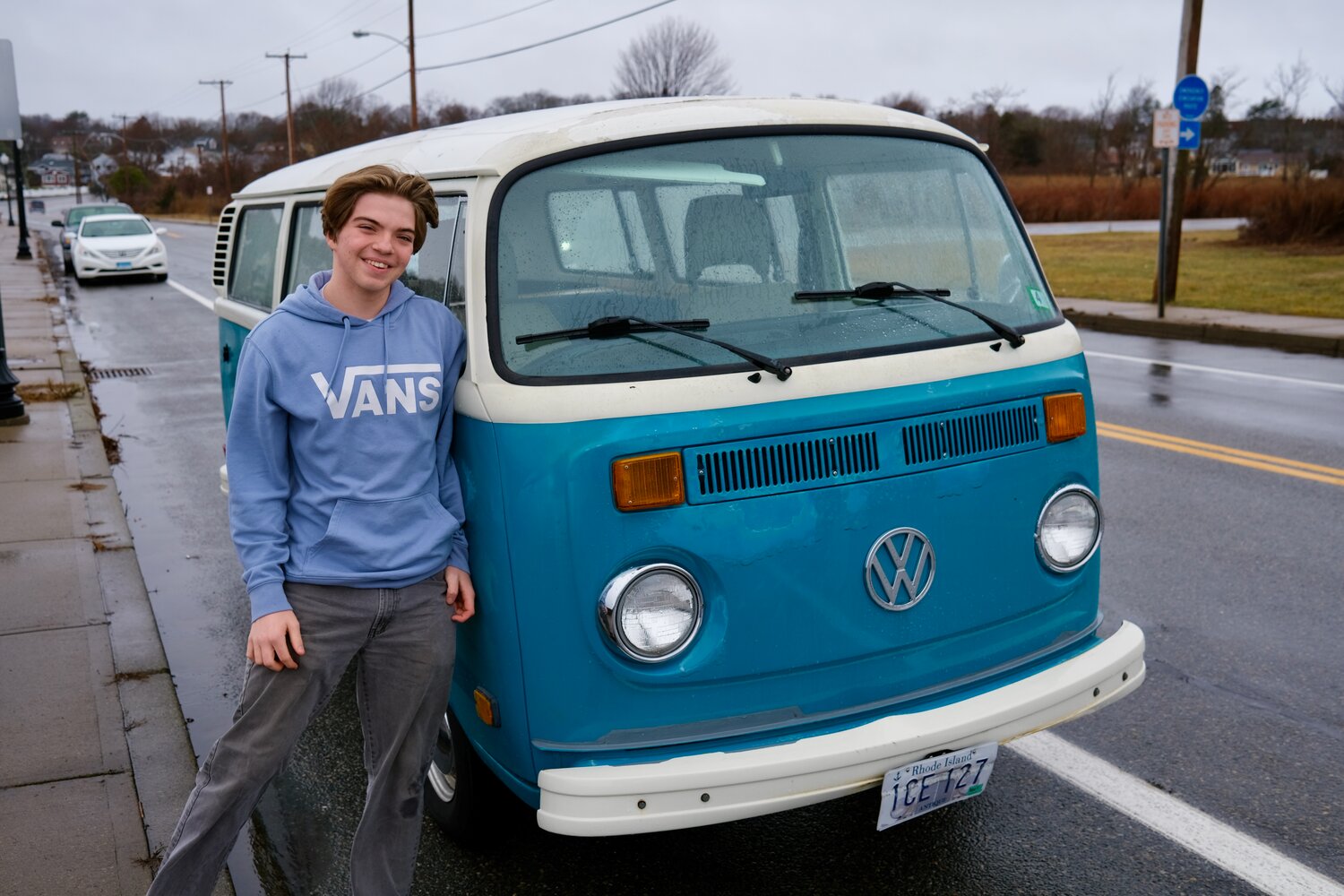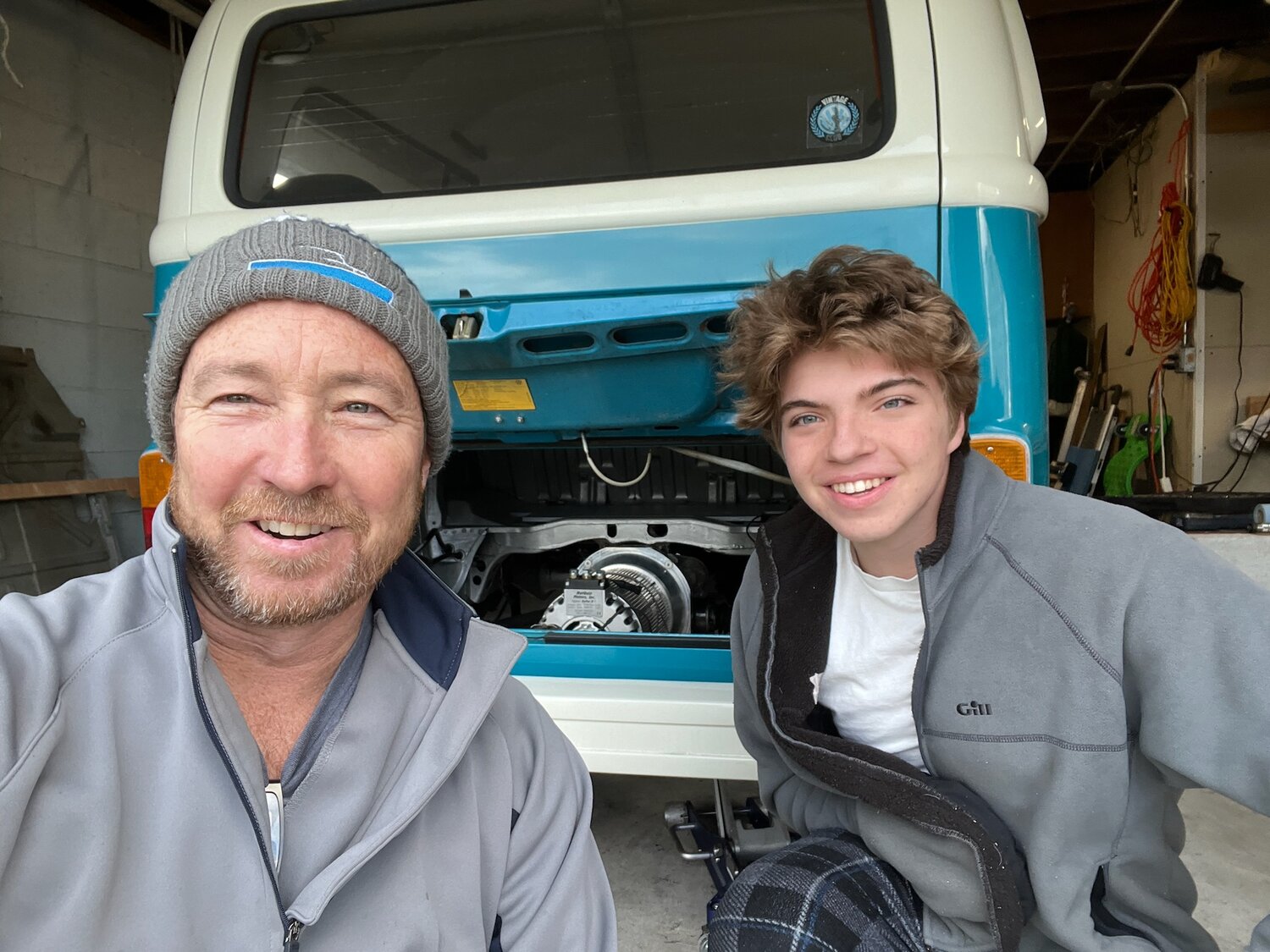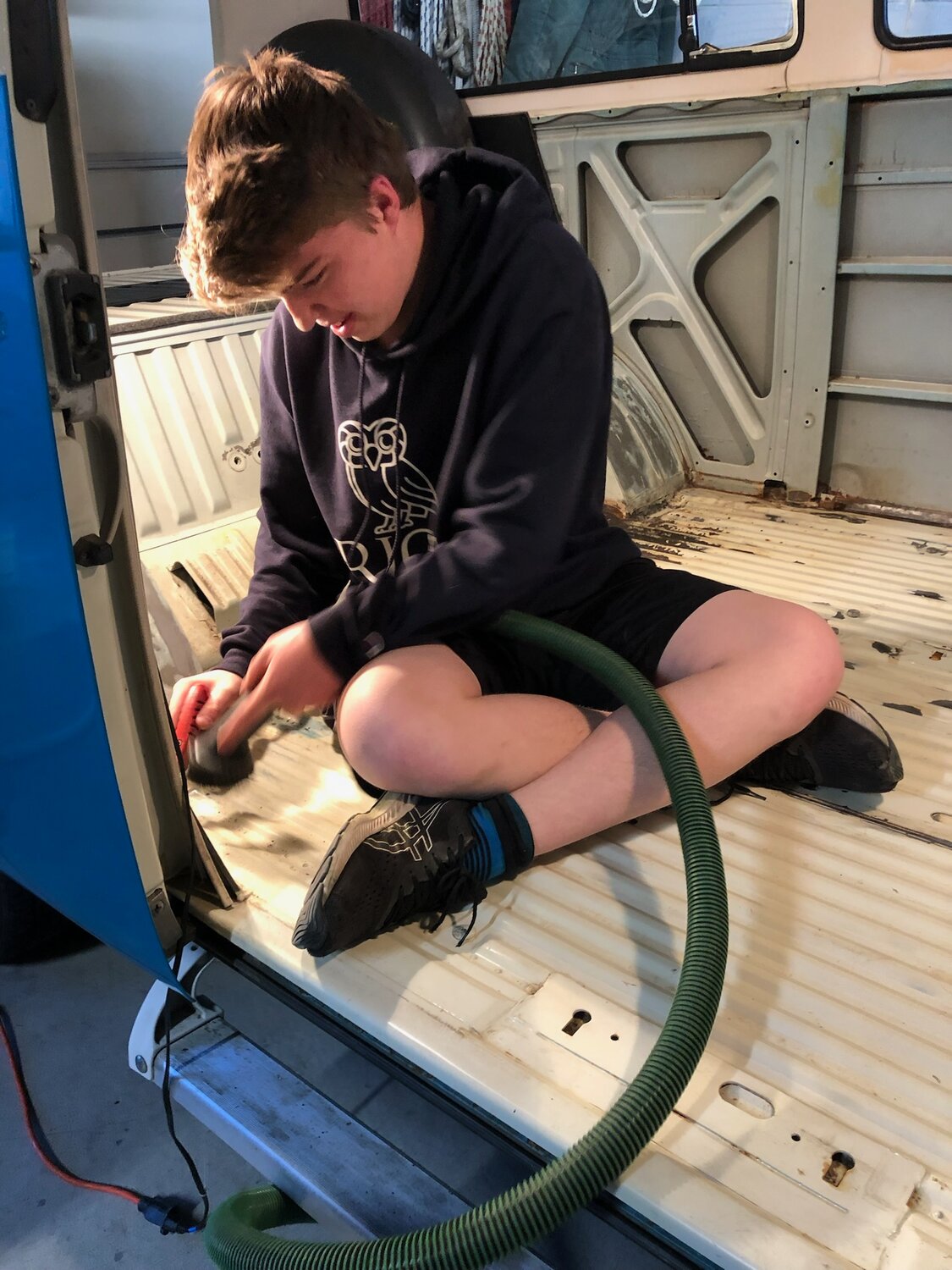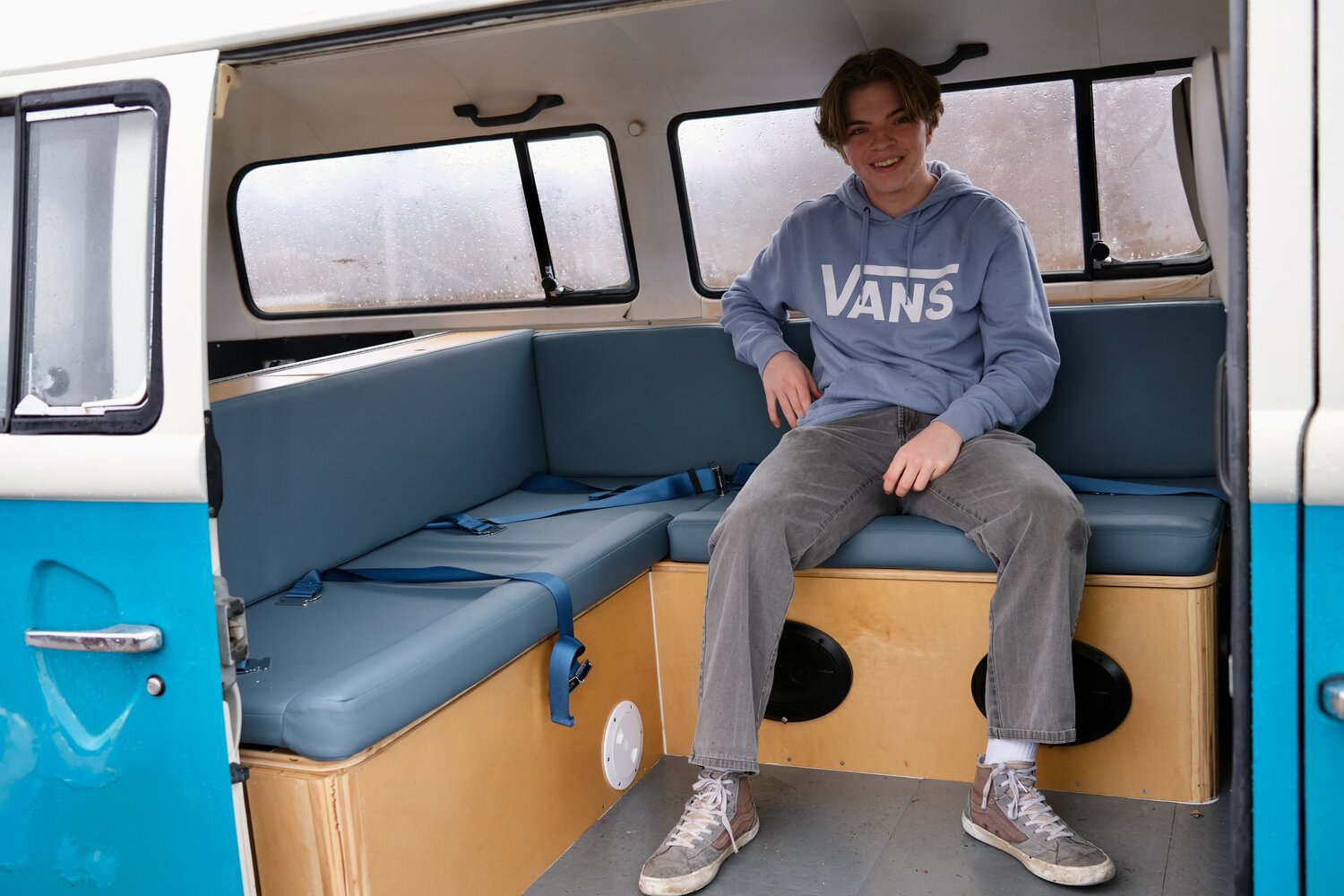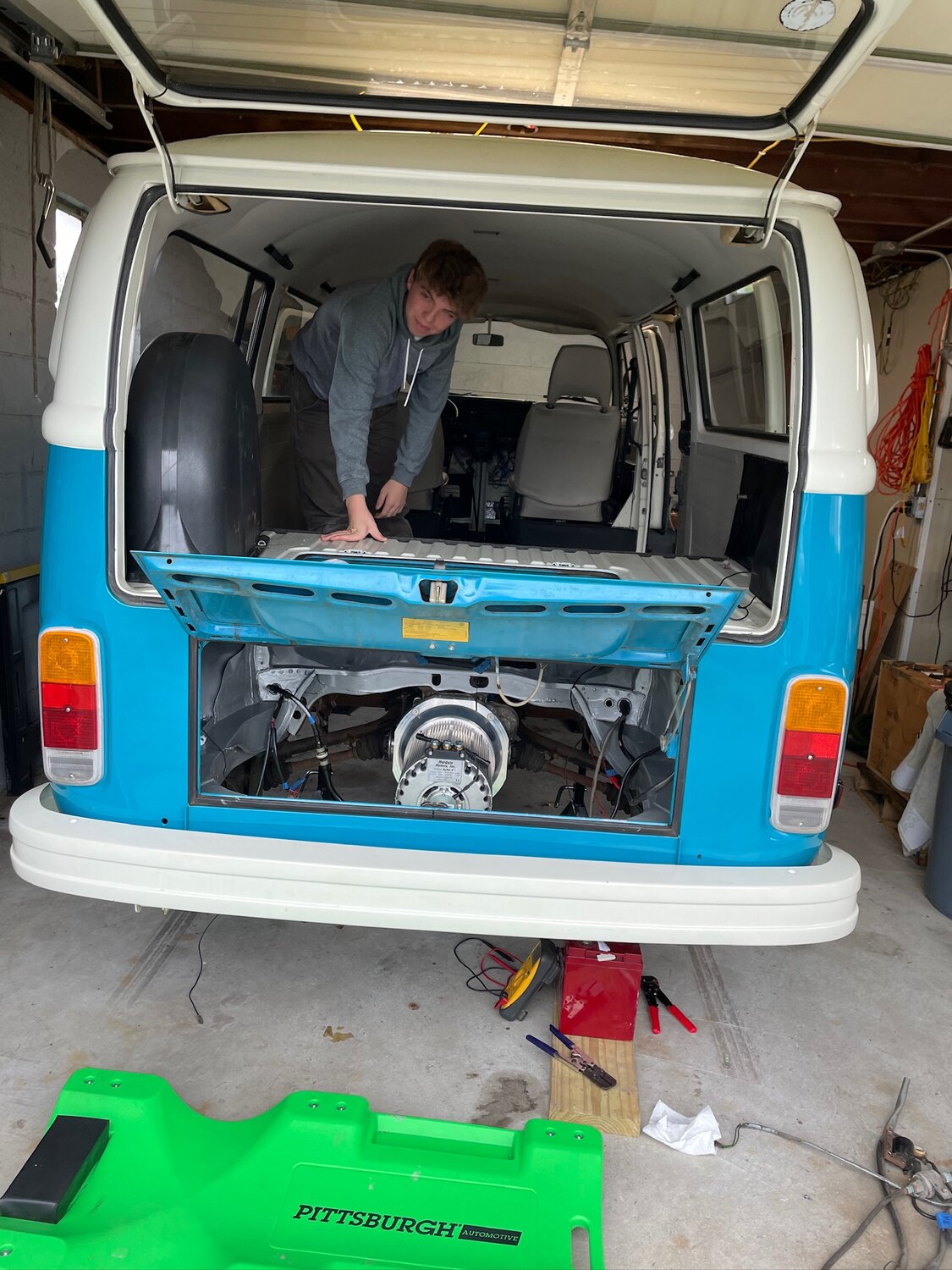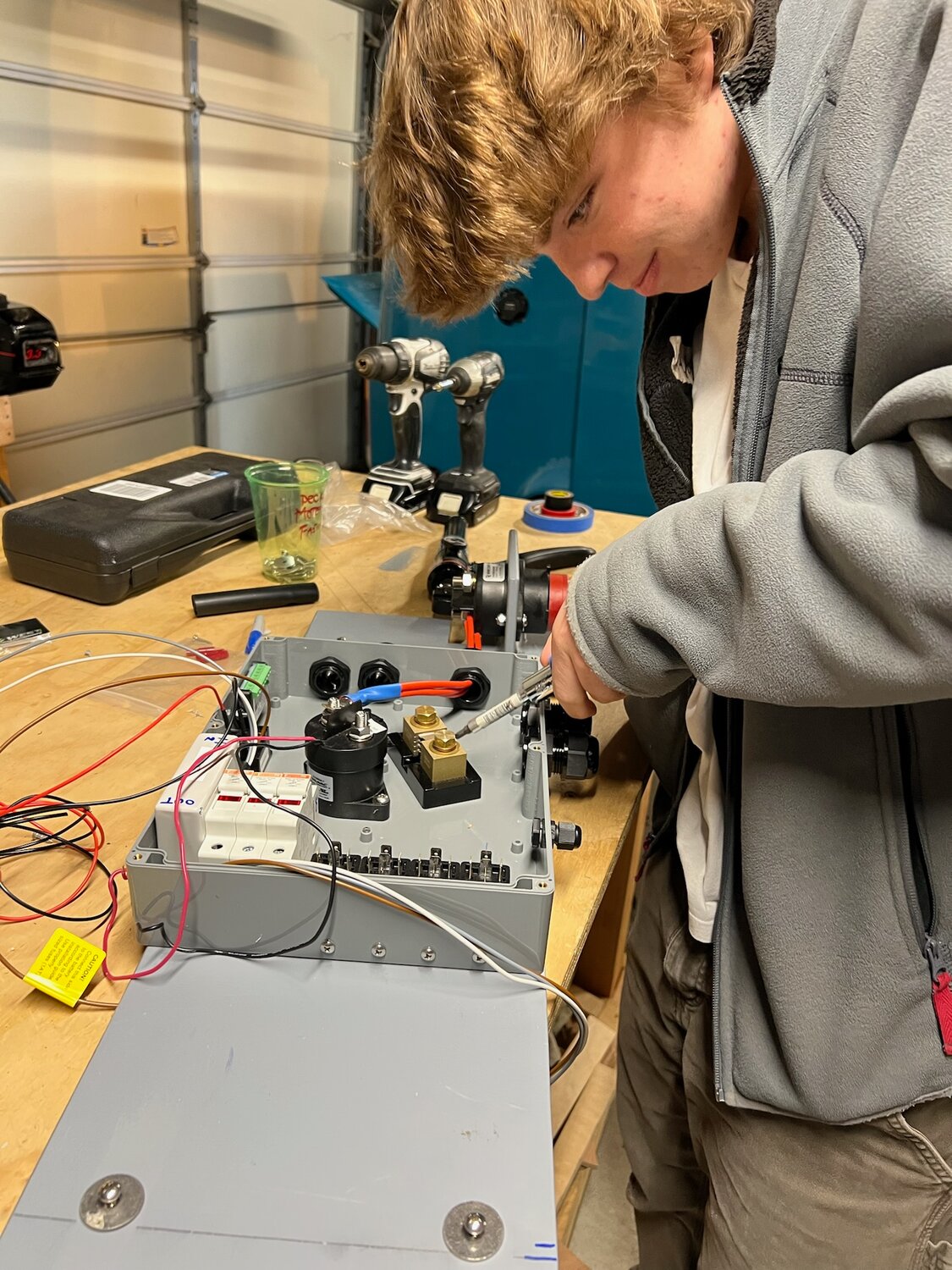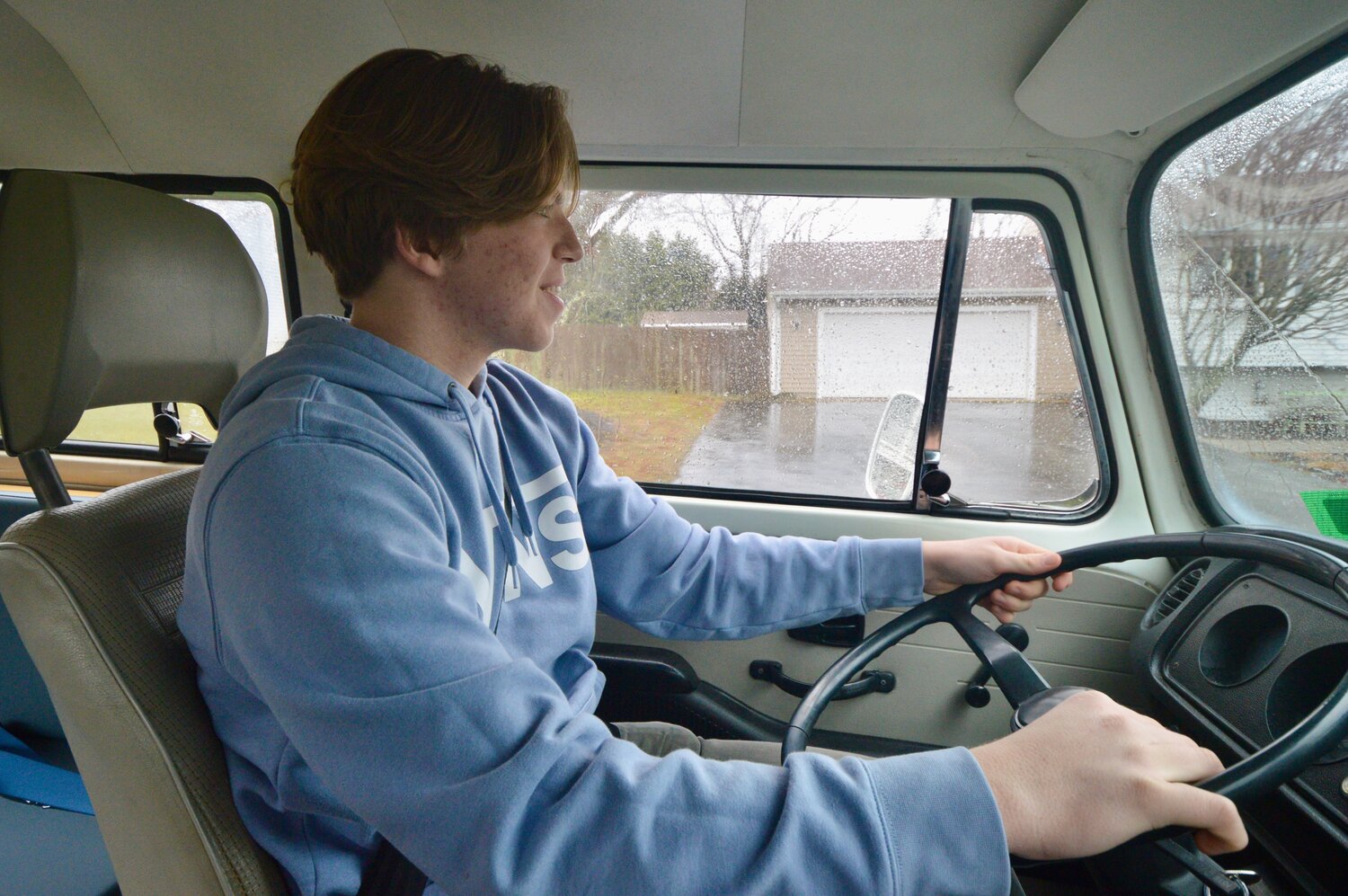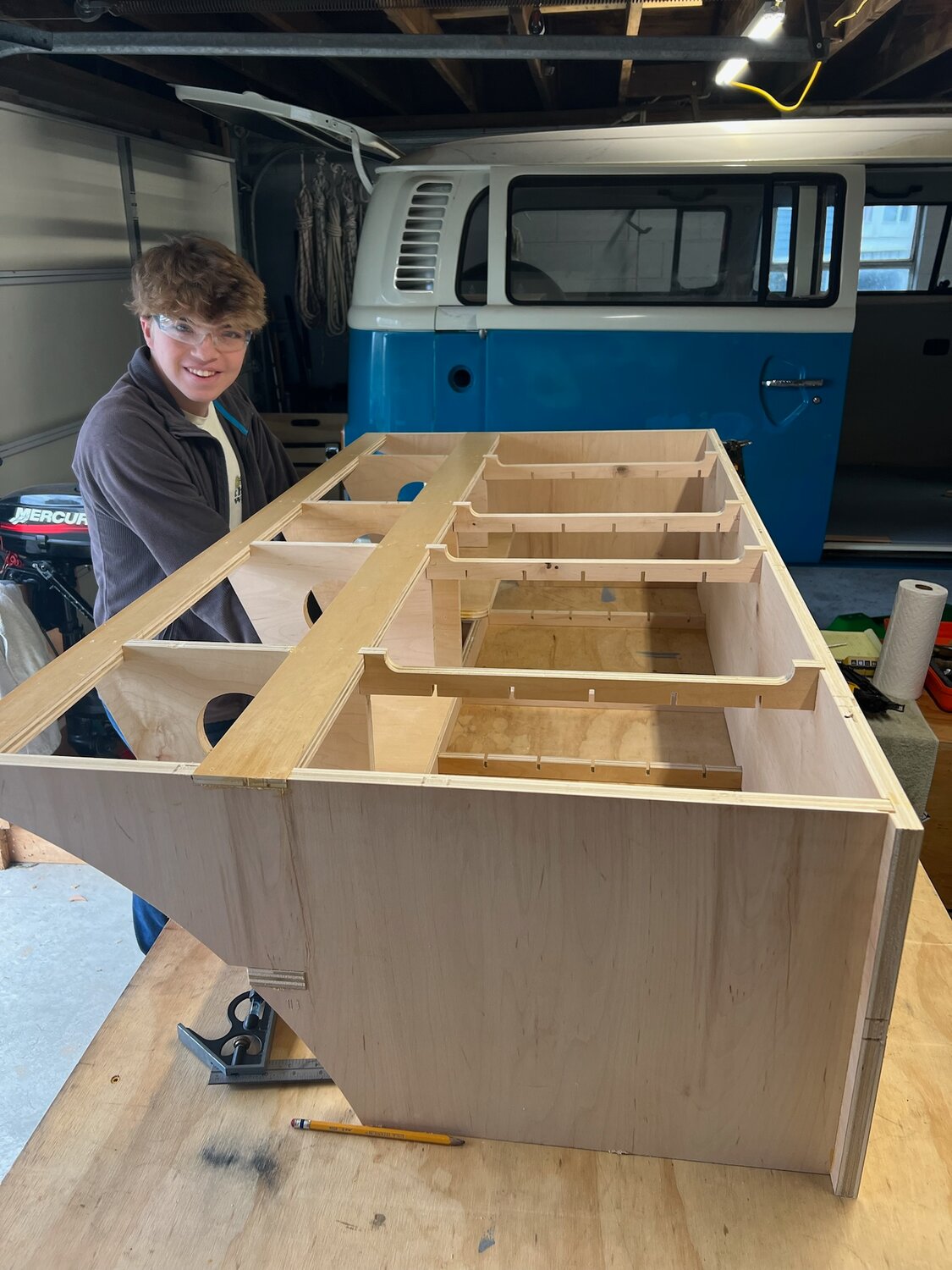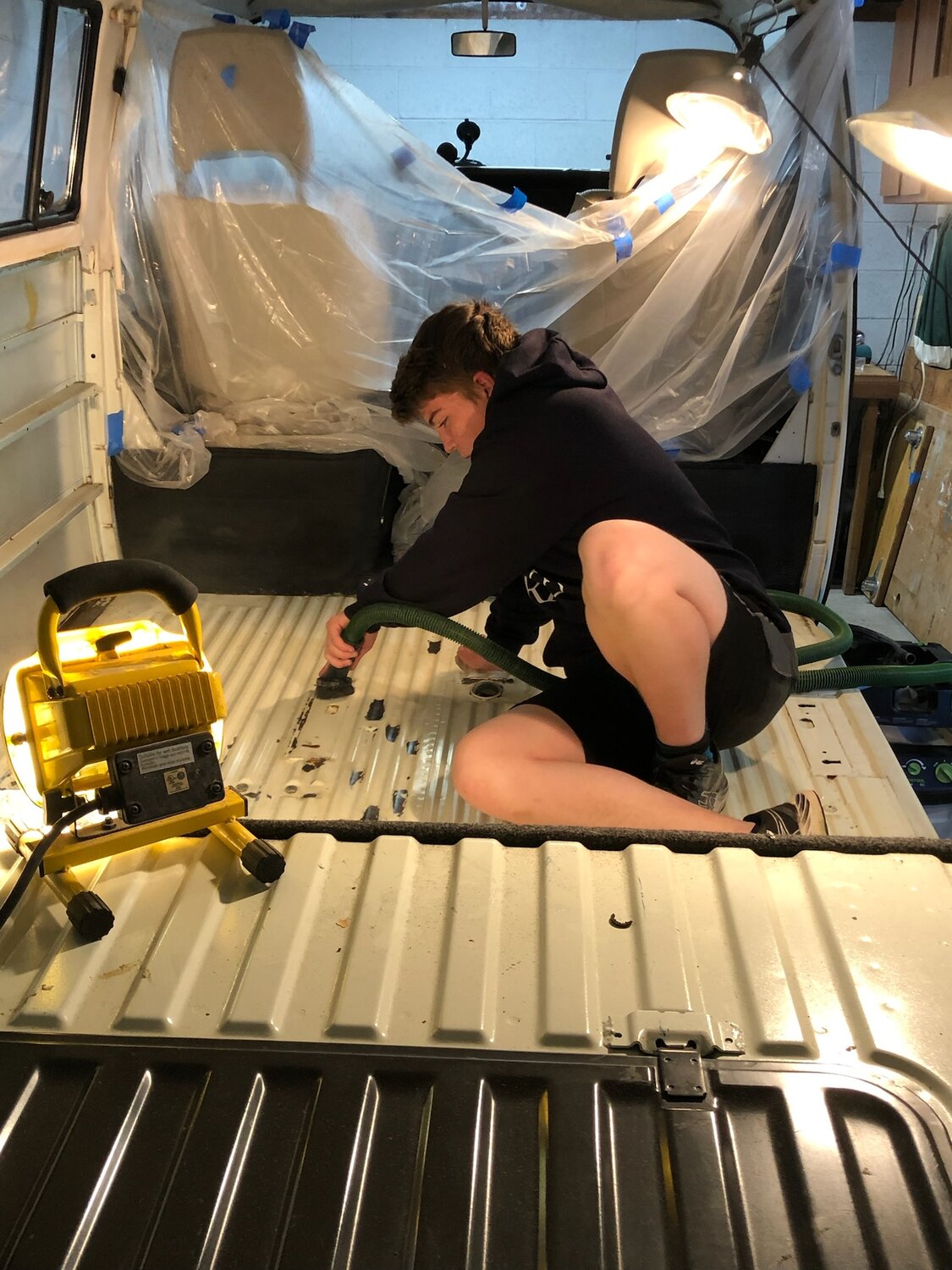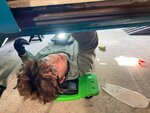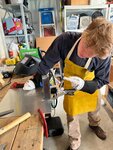- SATURDAY, APRIL 27, 2024
‘eVan’ is the ‘coolest car in Portsmouth’
Father-and-son project transforms 1977 Volkswagen van into electric vehicle
PORTSMOUTH — Maybe you’ve seen it cruising around town, this blast-from-the-past, blue-and-white van sporting antique plates and the iconic “VW” logo on its front end.
This item is available in full to subscribers.
Please log in to continue |
Register to post eventsIf you'd like to post an event to our calendar, you can create a free account by clicking here. Note that free accounts do not have access to our subscriber-only content. |
Day pass subscribers
Are you a day pass subscriber who needs to log in? Click here to continue.
‘eVan’ is the ‘coolest car in Portsmouth’
Father-and-son project transforms 1977 Volkswagen van into electric vehicle

PORTSMOUTH — Maybe you’ve seen it cruising around town, this blast-from-the-past, blue-and-white van sporting antique plates and the iconic “VW” logo on its front end.
Behind the wheel of the 1977 Volkswagen van is 16-year-old Wyatt Zani, a junior at Portsmouth High, who meanders around Aquidneck Island and beyond, sometimes with six or seven pals in the back. Perhaps they’ll use it to get to a track meet (Wyatt is a thrower on the PHS team), head down to Melville to grab a bite at Dashing Dan’s Cafe Car, or roll over to Sandy Point or Easton’s beaches this summer. Wherever it shows up, you can bet this retro-looking beast will turn heads.
One place you won’t find it, however, is the gas station. You see, this previous gas-guzzler — most 1977 models got between 10 to 15 miles per gallon — is now fully electric. It’s as if someone converted an old 8-track tape player into a digital music device.
Wyatt and his dad, Mike, have been working on the van on and off for the better part of two years, outfitting it with a new electrical system, Tesla batteries, seating, flooring, speakers and more — about 400 hours of work in total. Wyatt just recently got his driver’s license, and this is his first car.
“I think it’s the coolest car in Portsmouth,” Wyatt said while parked on Park Avenue one recent morning to show a reporter the fruits of his labor.
It all started two years ago.
“One of my neighbors had a ’64 bus,” said Wyatt, who lives in Common Fence Point. “I saw it every day and I loved it. I was talking to my dad about it, as we wanted to do some really cool project together. It was actually my dad’s idea to make it electric.”
Mike called someone he knew at Apache Automotive in Bristol, which specializes in, among other things, old Volkswagen vehicles. “He’s a former sailor, and he was keen to help,” said Mike, who used to build Vanguard Sailboats and was a coach for the 1996 U.S. Olympic Sailing Team during the Olympics in Atlanta.
They found the 1977 VW in New Hampshire, but its owner said seven people were already in front of them on the list to buy it.
“I told him my son and I were going to work on it and electrify it, and then he said, ‘It’s yours,’” said Mike, who promptly purchased the vehicle and brought it back to Rhode Island.
The van was in remarkably good shape, with little rust because it was stored in a garage for years. “It’s never seen a winter road,” Mike said.
The pair worked on the VW in a small, two-car annex garage unattached to their house. They decided to do the project in two parts, first attacking the superficial rust, installing an anti-vibration mat, and doing much of the layout and planning.
They also installed an L-shaped seating setup in the rear, which is one of Wyatt’s favorite features. It’s seating from a boat, basically, and also stores the vehicle’s batteries as well as Wyatt’s built-in speakers — including a subwoofer that faces the driver’s seat. It also features airplane seatbelts.
“I can fit about seven friends back there,” Wyatt said.
Taking it for a spin
They drove the bus in the summer of 2022 using its gas internal combustion engine, just to see how it handled.
“As soon as the fall came, we just went for it,” said Mike, referring to the biggest job: converting this gas-eating behemoth into a “modern” EV vehicle.
“There’s this company out of California called EV West that specializes in electrifying cars,” Wyatt said. “It’s definitely becoming more common, and it’s really popular in California. Here (on the East Coast) you don’t see it as much because the infrastructure for electrics isn’t as good, and I guess it’s less trendy out here. This car, the VF bus, is really popular to do all that. It’s simple enough; there’s not a lot of fancy engineering. But it’s also very open and you’re able to do a lot of things to it.”
EV West sold them most of the parts, gave them a few diagrams of what to do, “and said to call us if you ever need a handyman,” Wyatt said.
That was about it. They were basically on their own.
“They gave us all the raw materials for the big and important stuff, but left the rest for us to figure out. We got pretty much everything we needed, but we still had to Jerry-rig quite a few things like a few fuses and build all the construction ourselves. We had to put the batteries in and wire all the motors and everything,” he said.
He opened up the engine compartment located in lower rear of the van.
“We have two different electric systems in here — the 122 volt, which is what powers the motors and pretty much all the systems. And then we have the 12-volt house system, which is pretty much everything the car had before it was electric — your lights, your blinkers, your washers. But everything we installed on our own is on the other system,” Wyatt said.
Problem-solving
Wyatt and his dad had a little help their friends from time to time. “(My dad) had a huge list of connections, so if you ever had an electrical problem he has engineering friends, boat friends. One of his friends actually designed (the rear seats) which carry our batteries and all that. He did a beautiful job.”
His dad was “always handy” in the shop, Wyatt added. “He’d figure out a problem and build whatever he needed and make his own tools. He was really confident about this; I was much less confident. But over time, I was trying to get up to his level and even things out with him.”
That happened when they ran into their biggest problem, right after the vehicle was fully electrified and everything seemed ready to go last summer.
“The bus would just shut off and we could not get it to work,” Wyatt said. “We’d have to wait a couple of weeks and it would turn back on randomly. We spent a couple months trying to figure this problem out; it was pretty much unusable during those months.”
It turned out to be an issue with the vehicle’s computer, which calculates how much power to give the motor.
“How fast it spins, RPMs, all that,” said Wyatt. “It has a bunch of outputs we use to control various systems. One of these outputs had a bad ground; it was coming off and on. We didn’t know this until we called up the guys at EV West and asked them. What we did was hijack a different ground from somewhere else in the bus, connected it to that wire, and it worked real fine.”
“Son of a gun, everything turned green and in 45 minutes we were rolling,” Mike marveled. “He solved the problem.”
Expense vs. range
Not surprisingly, the project cost several thousand dollars to realize. The engine wasn’t the biggest expense; that would be the batteries.
“We have 10 of what Tesla uses for theirs,” said Wyatt. “Ten of them give us about 120 miles. I can charge it from nothing to full in about seven hours, but it’s better for the batteries if I take it slower, with about 12 to 14 hours to charge. I can plug it right into a wall, or I can use a Tesla charger; at home I can use my mom’s.”
Wyatt said he still doesn’t know the exact range of the van. “Tesla uses 16 of these batteries to get 300 miles. But this is a bigger and less-aerodynamic car, so it takes 10 batteries to get 120 miles,” he said. “We’re kinda of eyeballing it, but I have a monitor which tells me the voltage that the engine is putting out at all times. As your power gets lower and lower, your voltage is going to slightly drop. So, I can eyeball that slight drop and kind of estimate in my head how much power we have left. Right now, I’ve been running it for a few days and it’s probably on like 20 or 30 percent power.”
In any event, Wyatt isn’t planning on any long road trips in his van; he’s content to putt around town and a little beyond. He’s also aware that his van — and EVs in general — aren’t for everyone.
“EVs are here to stay and they’re definitely going to become more important, but right now I don’t think they’re practical enough for everyone to have,” he said. “This works for me because I never leave more than 40 miles away from Portsmouth. All I do is cruise around the island and go to beaches. For someone like me, it’s perfect and I’m not doing anything important with it. But for someone who’s commuting to work, like going to Boston every day, it’s not feasible to have an electric car. It takes way too long to charge. If you’re a contractor, you need a big truck; (EVs) can’t haul as much reliably. And, they’re a lot more expensive right now.”
Because Wyatt’s van is considered a vintage vehicle, it has antique plates. Basically, that means no emissions test is necessary during inspections. Of course, the point is moot in this case.
“For a car this old, they just test for lights. If there was a test, they’d find there was no tailpipe,” Mike said.
Wyatt said he doesn’t know of anyone on the island who has a vehicle like his. “There are people with antique cars, but I think I have the only antique electric,” he said.
Worth it?
Some may question the practicality of pouring thousands of dollars into electrifying an antique vehicle, especially when it has such limited range. Why not just buy a modern EV that gets at least twice the mileage range?
Mike said the only people who do electric conversions are those who want an “emotional return on their investment.”
“It has become popular with old classic cars that were becoming hard to maintain, and this gives them a new lease on life. Lighter vehicles also are good because they are more easily driven,” he said.
Wyatt’s vehicle doesn’t fit that description, of course, but Mike said the project has also been worth it for another reason: He learned a lot about his youngest son during the time they spent together.
“The real gift was spending 400 hours with my son in a garage. We are literally so much tighter as a result,” said Mike, adding he learned much about his son — such as what a good sense of humor he has.
“He probably wouldn’t crack a joke like that in front of mom,” he recalled thinking during one conversation.
Mike said he also learned how attentive Wyatt was. “He’s an introvert who doesn’t talk much, but he proved how much he learned from watching videos and doing other research. Thirty-five hours of sanding sucks, but he did it,” Mike said. “Most kids don’t put 400 hours into something.”
Wyatt said the key was to not get overwhelmed and take each task as it comes.
“It’s a hard project and I was drowning at the beginning. But if you take it in pieces, it’s a lot easier than you think,” he said.
Keywords
electric vehicles, EV vehicles, renewable energyOther items that may interest you

